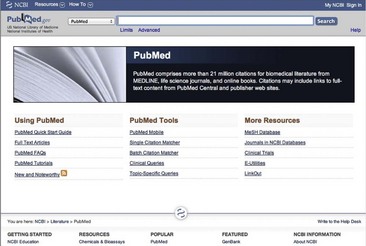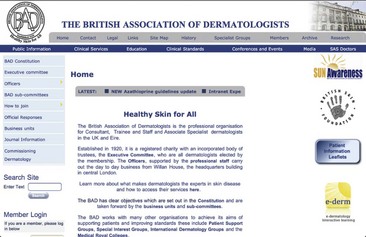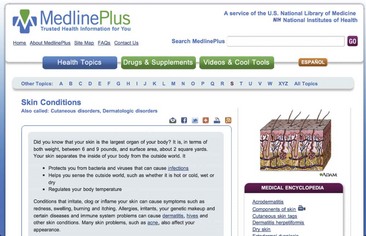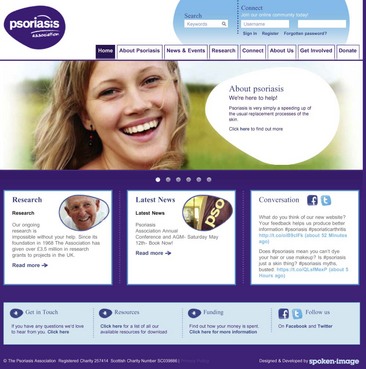Dermatology and the Internet
The widespread availability of access to the Internet has had profound effects on dermatology. Doctors and students now have unlimited access to medical information, patients have readily available facts or opinions about their conditions, and both clinicians and patients have the possibility for remote consultation by ‘teledermatology’.
The Internet as a library
Databases
Searches can be made through databases such as PubMed (http://www.ncbi.nlm.nih.gov/sites/entrez) (Fig. 1) and online written information obtained through search engines such as Google (http://scholar.google.com/). Another useful resource is McKusick’s catalogue of inherited diseases (http://www.ncbi.nlm.nih.gov/sites/entrez?db=omim).
Organizations
All the major dermatological organizations have their own Websites that give practical details for clinicians and patients, e.g. the British Association of Dermatologists (http://www.bad.org.uk/) (Fig. 2), the European Academy of Dermatology and Venereology (http://www.eadv.org/) and the American Academy of Dermatology (http://www.aad.org/). Most large international institutions have their own Websites, e.g. the World Health Organization (http://www.who.int/).
Education
There are Websites specifically dedicated to education, such as emedicine (http://emedicine.medscape.com/dermatology), MedlinePlus (http://www.nlm.nih.gov/medlineplus/skinconditions.html) (Fig. 3) and the New Zealand Dermatological Society (http://www.dermnet.org.nz/index.html). Another useful site is an online atlas, e.g. the Dermatology Image Atlas (http://dermatlas.med.jhmi.edu/derm/).
Evidence-based medicine
In an age when the clinician is called upon to defend his or her practice, it is useful to know that there are Web pages dedicated to providing details and analysis on the true benefit or otherwise of many valuable therapies. The Cochrane Skin Group’s Website (http://skin.cochrane.org/) and the National Library for Health (http://www.evidence.nhs.uk) are invaluable resources.
Journals
Many journals are available online, often through a publisher’s Website; for example, Synergy (http://onlinelibrary.wiley.com/) provides the British Journal of Dermatology, and Nature (http://www.nature.com/jid/index.html) provides the Journal of Investigative Dermatology. Archives of Dermatology can be obtained at http://archderm.ama-assn.org/, Dermatology in Practice at http://www.dermatologyinpractice.co.uk/dip/default.asp and Elsevier journals at http://www.elsevier.com/wps/find/journal_browse.cws_home. Often, only abstracts of articles are provided, although, for subscribers, a password will permit full access.
Guidelines
Clinicians in search of guidelines will find useful the Web pages from the British Association of Dermatologists (http://www.bad.org.uk//site/622/default.aspx) and from the National Institute for Health and Clinical Excellence (NICE; http://www.nice.org.uk/).
Links
Some Web pages specialize in providing links to other resources, e.g. the Hardin Library (http://www.lib.uiowa.edu/hardin/md/derm.html) and the British Association of Dermatologists (http://www.bad.org.uk//site/484/default.aspx).
Resources for patients
Patient websites
Web pages designed for use by patients can be very informative. Good examples include DermIS (http://www.dermis.net/dermisroot/en/home/index.htm), and ones from the New Zealand Dermatological Society (http://www.dermnetnz.org/) and the American Academy of Dermatology (http://www.skincarephysicians.com/). MedlinePlus (see above) also has an excellent medical encyclopaedia for patients, and reliable information can be obtained at Yahoo Health (http://health.yahoo.com/).
Patient support groups
Many excellent Web pages are available (p. 132). The Iowa University Web page (http://www.healthcare.uiowa.edu/dermatology/SuprtGrps.html) contains a comprehensive list including groups for rare conditions. Several sites give fact sheets about skin conditions and their treatment. Worth a particular mention are those from the Skin Care Campaign (http://www.skincarecampaign.org/), which gives a comprehensive list of patient support organizations, the UK National Eczema Society (http://www.eczema.org/) and the Psoriasis Association (http://www.psoriasis-association.org.uk/) Website (Fig. 4).
Handouts and patient information leaflets
The British Association of Dermatologists continues to update and expand its collection of patient information sheets which are invaluable when counselling patients about a disease or discussing the possibility of systemic therapy (http://www.bad.org.uk). Certain Websites specifically produce handouts for patients, e.g. RxMed (http://www.rxmed.com/).
Teledermatology
Accuracy
Dermatology and the Internet
 Databases, e.g. PubMed, are used to search for medical information.
Databases, e.g. PubMed, are used to search for medical information.
 Professional organizations, e.g. the European Academy of Dermatology and Venereology, have Web pages for use by clinicians and patients.
Professional organizations, e.g. the European Academy of Dermatology and Venereology, have Web pages for use by clinicians and patients.
 Educational resources for students include MedlinePlus and the Dermatology Image Atlas.
Educational resources for students include MedlinePlus and the Dermatology Image Atlas.
 Evidence-based dermatology is accessed via the Cochrane Skin Group’s Web page.
Evidence-based dermatology is accessed via the Cochrane Skin Group’s Web page.
 Online journals are obtained via the publishers’ Websites.
Online journals are obtained via the publishers’ Websites.
 Guidelines can be viewed, e.g. from NICE or the British Association of Dermatologists.
Guidelines can be viewed, e.g. from NICE or the British Association of Dermatologists.
 Patient support groups have numerous Web pages, e.g. Skin Care Campaign.
Patient support groups have numerous Web pages, e.g. Skin Care Campaign.
 Teledermatology may be of value for skin problems that occur in people who live in remote areas.
Teledermatology may be of value for skin problems that occur in people who live in remote areas.





